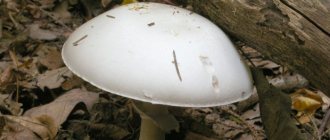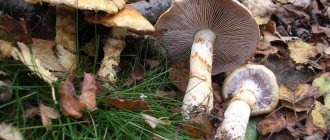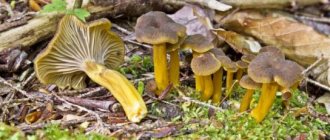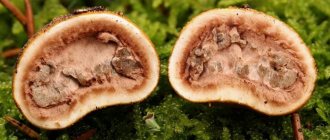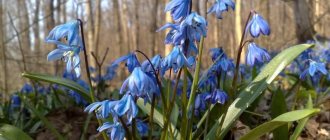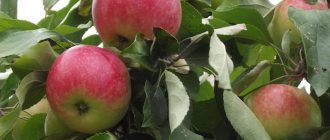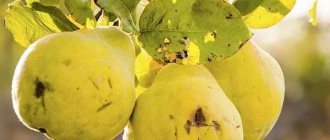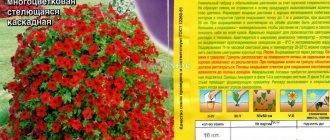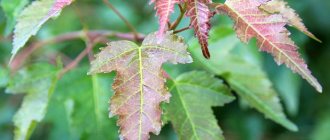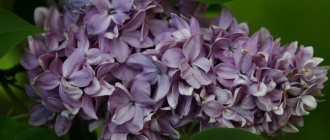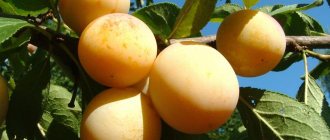3.7 / 5 ( 4 voices)
Royal honey mushrooms (lat. Pholiota aurivella or Pholiota adiposa), willow mushroom, golden scale, sulfur-yellow scale, sebaceous scale or thick scale - an edible mushroom that many mushroom pickers, especially Europeans, neglect, preferring to take more famous representatives of the mushroom kingdom. But in the East, in China and Japan, it is not only collected, but also cultivated on an industrial scale, used in medicine and in the preparation of national dishes. According to research by Chinese scientists, the royal honey fungus is much superior in its nutritional value and medicinal properties to more popular types of mushrooms. The extract from it has fungicidal, bactericidal and immunomodulatory effects.
Taxonomy
What honey mushrooms look like and what species are found in our forests, we told you in more detail about many representatives of the strophariaceae family, so as not to repeat ourselves, we’ll just remind you that it belongs to the order of agaricaceae of the strophariaceae family. It belongs to the genus of scales and has a composition that is beneficial to the human body.
The real name of this mushroom is not royal honey fungus (royal), but golden scale, and a little later we will find out for what reasons it deservedly received this nickname.
Similar types and differences from them
Its related flakes are similar to the ordinary one:
- scaly - smaller and lighter, with a sticky whitish cap, conditionally edible;
- golden or herbal - painted golden yellow, the cap is granular without scales, the stem has a large membranous ring hanging down, has the smell and taste of bitter almonds, is considered conditionally edible, grows in abandoned settlements, on rich soils, in nettle thickets ;
- fiery - bright yellow, with lemon-colored scales and yellow-orange pulp, often has a bitter taste, especially if it grows near spruce trees, and is also classified as conditionally edible.
The autumn honey fungus (Armillaria mellea) is also similar, but it does not have large scales.
Ordinary flake, whose properties are known only to connoisseurs, forest healers and mushroom gourmets, requires mandatory cooking with preliminary boiling. Due to its wide distribution and the absence of poisonous properties even in similar species, collecting it is not only easy, but also safe.
Description of appearance
Royal honey mushrooms or golden scale
Most of them have a large bell-shaped or flat cap (about 1/3 of the mushroom). Red flake-like scales cover the rusty-yellow area of the cap. It looks like a crown, which is why it received the above-mentioned nickname among the people.
The leg has a dense consistency, with a large number of scales, which in young individuals was a skirt.
The pulp tastes pleasant, rarely tastes bitter and has a pleasant mushroom aroma with a slightly yellowish palette of yellow tint.
They prefer to live in large families of five or more
Edible types of flakes
In nature, there are several species that differ from each other in color and size. They have excellent taste and have beneficial properties, so mushroom pickers need to be able to recognize them among other mushrooms.
Ordinary
This is an edible cap mushroom with a light brown, sandy or ocher color. The entire surface of the mushroom is covered with dark, pointed scales. Young specimens have a hemispherical cap; over time it straightens and becomes flatter.
The leg of the common flake is dense, solid, and has the shape of a cylinder. In tall mushrooms, it may be slightly curved and narrowed at the base. The color usually matches the cap.
The plates of the mushroom are thin and frequent, tightly growing to the stem. In young fruits they are light, but over time they become brown. The pulp is tasty, nutritious, and bitter in the stem.
It grows on stumps and diseased trees mainly in late summer and early autumn. Used boiled, fried and pickled.
Borovaya
The hog flake has a yellow cap with remnants of a spathe on the surface. In young specimens it is hemispherical, in mature specimens it is spread out with a small tubercle in the middle. A distinctive feature is the uneven edges, slightly sticky to the touch.
The leg is cylindrical, not high. Can be straight or bent, yellow or orange. It is always hollow inside, so it is not eaten.
Rare pointed scales are found on the surface of the fruit. At first they match the color of the skin, but over time they darken and acquire a rusty tint. The pulp is bitter and has almost no aroma. It is usually yellow, slightly darker in the center.
Upland scale grows near the roots of coniferous trees. It is found in both mixed and coniferous forests. It is eaten after preliminary boiling.
Composition of royal mushrooms
We will begin to review the chemical composition with the mineral content per 100 grams (values in grams):
- 0.0008 iron
- 0.045 phosphorus
- 0.4 potassium
- 0.005 sodium
- 0.02 magnesium
- 0.005 calcium
This is not a complete composition, it also contains nicotinic and folic acids and many vitamins per 100 grams (values in grams):
- Vitamin "E" 0.0001
- Vitamin "PP" 0.0107
- Vitamin B3 0.0103
- Vitamin B2 0.00038
- Vitamin B1 0.02 grams
- Vitamin C"
For people who are losing weight, this will be an ideal product with a negligible calorie content - only 22 kcal and (values in grams):
- 1.2 fat
- 0.5 carbs
- 2.2 proteins
- 1 ash
- 89.1 water
- 5.1 dietary fiber
- 0.5 mono and disaccharides
Amino acids contained in the composition per 100 grams (values in grams):
- Glutamic acid 0.343
- Aspartic acid 0.195
- Alanine 0.199
- Valine 0.232
- Lysine 0.107
- Leucine 0.12
- Threonine 0.107
Application
Royal honey mushrooms are edible, but they are consumed only after heat treatment. Golden flake is often added to salads or gravies. It is used both in cooking and in medicine, because it is a valuable product containing proteins, carbohydrates, minerals and vitamins.
Golden flake promotes the production of hormones by the pituitary gland of the brain, so it is added to the diet for treatment and removal of excess cholesterol from the blood. Weekly consumption of these mushrooms improves the condition of the skin and hair, strengthens blood vessels.
In cooking
Popular dishes made from the fruiting bodies of the scale are soups, sauces, stews and pickles. Famous chefs make their marinades and pies. For such dishes, only the caps are used; for preservation, the entire mushroom is used. Before any preparation of royal honey fungus, the following processing is carried out:
- cut off the lower part of the leg;
- thoroughly wash the mushroom to remove dirt and possible insects;
- boil for about 20 minutes in salted water;
- Allow excess liquid to drain, discarding the mushrooms in a colander.
There are several ways to store mushrooms, depending on the heat treatment. Salted or pickled products are stored in a room with a temperature of +2…+10°C.
In medicine
The golden flake mushroom contains squarrosidine. This is a unique substance responsible for the crystallization of uric acid in the kidneys and joints. It prevents the precipitation of urate salts: it reduces the strength of a painful attack in a patient with gout.
Irina Selyutina (Biologist):
Urates are plasma-soluble sodium and potassium salts found in uric acid. In the human body, urates can be deposited in:
- kidneys and bladder as part of stones;
- joints in the form of gouty deposits.
Thus, squarrosidine, present in royal honey mushrooms, suppresses the work of the enzyme xanthine oxidase, preventing it from forming crystallization of uric acid in the joints. If this happens, the disease gouty arthritis develops. Therefore, active development of anti-gout drugs based on squarrosidine flake is currently underway.
From these mushrooms, tinctures and decoctions are made that help in the treatment of diabetes and thrombophlebitis. The drink contains anticoagulants that reduce blood clotting. To do this, drink the tincture once every six months for 2 weeks. Drinking this drink also helps prevent the occurrence and growth of tumors.
A decoction of royal honey mushrooms treats atherosclerosis and varicose veins. It increases blood flow to the heart and brain without increasing blood pressure. By using the tincture, you can improve your vision and relieve inflammation of the eyes.
100 g of mushrooms saturate the body with the daily norm of copper and zinc. For those suffering from anemia, they are useful for their high content of iron and magnesium, which are involved in hematopoiesis.
The effect of beneficial substances of golden flake on the body
All biologically active elements (nutrients) have a positive effect on the body as follows:
- Phosphorus is involved in biosynthesis and is responsible for the metabolism of proteins, proteins, lipids and carbohydrates
- Vitamin “C” restores the nervous system and protects the walls of blood vessels from cholesterol deposits. Increases immunity and protective functions of the body, and also participates in all reductive and oxidative processes
- Vitamin “B3” helps beneficial substances to be absorbed in our body and promotes the production of sex hormones. Breaks down proteins and lowers sugar levels. Neutralizes dangerous substances in the body.
- Potassium is involved in the normalization of the processes of the cardiovascular system. Controls sodium chloride and acts as a regulator of water and electrolyte balance. Responsible for the absorption of magnesium
- Magnesium is responsible for improving bone structure and digestive function. Prevents the deposition of stones (calculi) in the bile ducts and kidneys. Strengthens the structure of muscle and nerve tissues, stimulates the restoration and growth of soft tissues.
- Vitamin B2 improves the functions of the reproductive organs. Thanks to it, the peripheral and central nervous systems normalize their work. Intercellular and intracellular metabolic processes accelerate their work. Hemoglabin is produced faster.
- Vitamin “P” helps the body increase the protective functions of the thyroid gland and neutralizes viruses. Regulates cholesterol in the blood and relieves vascular spasms. Reduces the volume of triglycerides in the blood and accelerates the process of intoxication.
Growth conditions do not in any way affect the quantity and quality of all of the above beneficial substances in honey mushrooms.
Description and photo
Let's talk about what royal honey mushrooms or golden flakes look like (that's what mushroom fruits are called officially, according to the textbook), and also where they live.
The height of a ripe mushroom can reach 18-20 centimeters, while the cap is not inferior in size to the stem and can also grow to a diameter of 19-20 centimeters. Mushroom pickers prefer to collect medium-sized mushrooms, not exceeding 10-12 centimeters, due to their visual attractiveness and denser texture.
The main distinctive feature of the honey mushroom we are considering is that the mushroom does not grow in a large colony, but in small “families.” Sometimes independently, identical to royal or boletus mushrooms. The color of the fruit is yellow, with a rusty tint. The older the specimen, the darker its skin. The surface is rough, strewn with frequent, small scales. There must be a soft fibrous ring on the leg, which disappears as the body ages.
Under the cap there are frequent, light-colored plates.
The ripening period of the crop is the warm season, approximately from the end of May to the beginning of September, it may vary depending on the region and climate.
Beneficial properties for the body
Their benefits were noticed a very long time ago, so healers from different countries advise including them in the seasonal diet thanks to this list of beneficial effects on the body:
- Prevention and reduction of the likelihood of the formation of benign tumors.
- In diabetes, improves the general condition of the body
- The likelihood of developing atherosclerosis, thrombophlebitis and varicose veins is reduced
- Blood circulation in the brain is stabilized and due to this the likelihood of heart attack and stroke is reduced, gradually disappearing
- Stimulation of phagocyte production
- Strengthening the overall level of immunity
- Increases efficiency and overall tone of the body, thereby eliminating fatigue and lethargy
Contraindications and possible harm from consuming royal flakes
Although the mushroom is edible, it still has some contraindications before consumption, which are mainly caused by the inability of the mushroom picker who collects it. If the mushroom was collected near a busy highway or highway, then there is a possibility of developing intoxication of the body with salts of heavy metals and carbon monoxide, which the mushroom is likely to absorb.
Pancreatitis and other serious diseases of the stomach and intestines are also a contraindication to eating honey mushroom. If the symptoms of the disease weaken, then one-time use will not harm the human body.
To avoid possible negative effects from consumption, pregnant and lactating women, as well as children under 3 years of age, should abstain. Pregnant and lactating women should choose lighter foods, and children simply may not have enough enzymes to process them.
There is one absolute contraindication - individual intolerance to mushrooms or mushroom meat of this species.
These mushrooms are not suitable for snacking on large amounts of alcohol.
Possible symptoms:
- Visual hallucinations
- Increased body temperature
- Facial redness
- Tremor of limbs
- Tachycardia and difficulty breathing
- Vomiting, nausea and painful abdominal cramps
A comatose state that will require calling an ambulance will be caused by severe intoxication.
Where they grow, in what forests and how to collect
You may be interested in: How do edible talkers differ from false mushrooms? How many days after rain do mushrooms grow? Bitter mushroom: photo and detailed description
Scales grow mainly in deciduous forests (less often in coniferous ones) in small groups. They can also be found in park areas within the city. You need to look for mushrooms near the roots of deciduous trees, on the stumps and trunks of dying plants, etc. Sometimes flakes can be found under pine or spruce trees, but such mushrooms will be bitter, so they are not worth collecting.
In our area, these mushrooms are quite common and are found everywhere. There are especially many of them in the forests of Siberia and the Far East. They also grow in the Krasnodar Territory, Primorye and the Caucasus. Abroad, flakes are common in Europe, America and Asia.
When going mushroom picking, you need to take a sharp knife with you. It is important to cut off the found fruiting bodies as carefully as possible so as not to damage the rhizome. You need to collect all the fruits in the family at once, since small specimens will not survive on their own.
False doubles of the royal scale
Unfortunately, the hero of our article, like many mushrooms that are excellent in their taste and healing qualities, royal honey mushrooms also have poisonous counterparts. Having studied the appearance and growth characteristics of the mushroom and its counterparts in advance, you don’t have to worry about your health and the “purity” of the mushroom basket.
The most common and similar twins:
The false royal honey fungus is often the cinder flake . It is difficult to confuse them due to the absence of rings on the knife and smooth cap characteristic of the “original”. Another distinctive feature is the differently shaped cap, which in youth has a hemispherical shape, which later transforms into an outstretched one.
False royal honey fungus
The mushroom described in our article also resembles mucous flake . The hat gives away a fake - it has a bell-shaped shape in youth, the edges of which rise with age. This fact is completely unusual for golden flakes. They were called slimy due to the formation of characteristic mucus during rainy periods, which is also not typical for royal scale. Also unusual for a non-poisonous mushroom is the place where the poisonous “classmate” grows - the rotten and rotten remains of dead trees.
Scaly mucous membrane
Most often, common flake . Not only is it very common among mushroom pickers, but this scale also has the most common features with the royal honey fungus. Although ordinary flake does not have harmful properties for the body, but only healing ones, it is highly not recommended to eat it without proper processing. The opium contained in it can cause unpredictable effects. It can be identified by its hemispherical cap.
Common scalyfoot
Where to find
It should be clarified that royal honey mushrooms grow on old stumps and damaged tree trunks. They are also often found near the roots of dead trees. Fruiting of this variety of mushrooms occurs from August to October. Mushroom pickers living in Primorye collect royal honey mushrooms from May to September.
Golden scales often live on willow or alder, but in some cases they can also be found on birch trees. They are found a little less frequently on coniferous trees. Even experienced mushroom pickers can sometimes confuse royal mushrooms with false mushrooms.
It was already mentioned above that royal scales can be eaten. But before you cook royal honey mushrooms, they must be boiled for twenty to thirty minutes in lightly salted water. Due to the fact that this type of honey mushrooms is characterized by excellent taste, they are often added to salads, snacks and various dishes. Especially harmoniously, from the point of view of taste, flakes are combined with boiled or fried potatoes. In addition, they are prepared for the winter: salted, dried, pickled and frozen.
In rare cases, honey mushrooms are found in spruce and pine forests. The scale found in deciduous trees differs from the fruits growing in coniferous forests. The most important difference is that “pine” honey mushrooms have a bitter aftertaste and a darker cap. Royal honey mushrooms contain many of the following vitamins:
- E;
- RR;
- WITH;
- phosphorus;
- calcium.
In addition, these mushrooms are considered low-calorie, since one hundred grams of golden flake contains only 20-22 calories. Therefore, those who want to lose weight or vegetarians should pay attention to this product.
